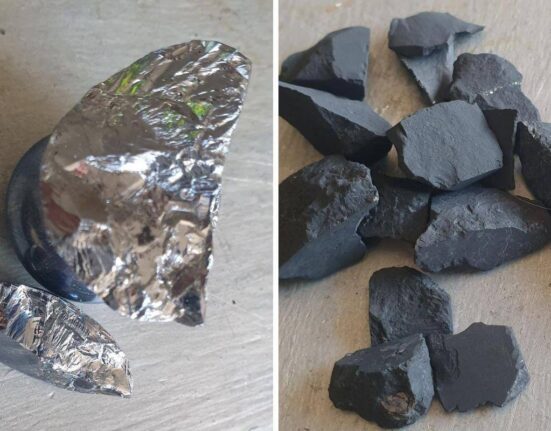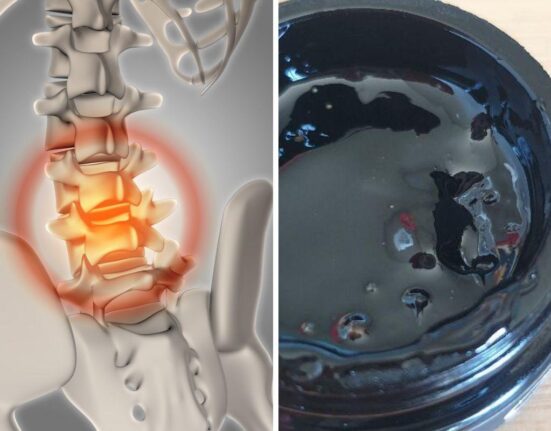Atrazine is a common chemical used in weed killers and other agricultural products around the world. When concentrations of this chemical herbicide exceed recommended levels in our water supply, it can cause serious harm to human health. This article will delve into:
- what atrazine is
- how atrazine is used
- detrimental effects atrazine has on our health and hormones
What Is Atrazine?
Atrazine is a broad-spectrum pre-emergent herbicide that works by preventing weeds from germinating or growing. It has been used since the 1950s to control weeds in crop fields such as corn and sugarcane, but more recently it has been found in other non-agricultural areas like yards and golf courses.

While it has generally been considered “safe” for years by regulatory agencies which have been shown that they cannot be fully trusted, recent studies have shown that overuse of atrazine may have serious implications for both humans and wildlife.
What types of weeds is atrazine used to prevent?
10 different types of weeds that atrazine in agricultural weed killers target in the early spring.
Yield atrazine weed killer spray application targets weeds before they are established. Weeds in the treated area with the active ingredient controls both emerged weeds and aids in the suppression of future seeds becoming established.
- centipede lawn grasses
- various annual clovers
- broadleaf weeds
- augustine grass
- annual bluegrass
- narrowleaf vetch
- chickweed
- knotweed
- crabgrass
- clover sandspur and others

Atrazine is used on our food, despite consideration for health of humans, plants and animals
Atrazine weed killer is a preferred choice big agriculture and for lawns and gardens looking to control weeds. The active ingredient in Atrazine provides effective weed control and suppression of almost all emerging broadleaf and grassy weeds, including crabgrass, spurge, clover sandspur, chickweed and others.
Atrazine’s effectiveness has been impressive enough for it to stand the test of time for big industry to keep using it, despite its health implications that we are starting to understand more clearly.
Is the convenience and of getting rid of all weeds chemically worth the potential cost to health?
This sounds all fine and dandy when not considering the ramifications of using a highly toxic chemical on humans, especially one that is disruptive to the human hormone balance.
One has to ponder what detriments can come from the killing of weeds, it is not without consequence.
Atrazine frog experiment and results
In 2000, two scientists at the University of California, Berkeley conducted a study to investigate the effects of atrazine on frogs. The researchers exposed African clawed frogs to different levels of atrazine over a period of 9 months and monitored their behavior.

Astonishing results after only 9 months
The results were astonishing; they found that male frogs exposed to low doses of atrazine grew ovaries and had reduced fertility.

This result strongly suggests that atrazine has the potential to disrupt hormone balance in humans, as well as amphibians. The findings of this study were reported to the EPA, which subsequently declared atrazine a “probable carcinogen” after weighing the evidence presented.
To be clear, the EPA was told that the male frogs grew female reproductive organs and in turn, the EPA labelled atrazine as a “probable carcinogen.” They did not label the product with any warning that pointed to the Berkley study where male frogs grew female organs, rather, they solely indicated that atrazine could cause cancer.
Long term repercussions of atrazine exposure
Atrazine is a classic example of an environmental pollutant with the potential to have adverse impacts on human and wildlife health. The effects of long-term exposure are still not fully understood, but studies like the one conducted by researchers at UC Berkeley suggest that even small amounts of exposure may be capable of disrupting our hormone balance and causing other health.
Humans have been subjected to steadily increasing amounts of atrazine in the environment. At the same time, cancer rates are exploding, and so is the LGBTQ community. Could it be related?
Gallup Poll: 100% increase in non-hetero-identifying people in 9 years
A Gallup poll with a sample size of 12,000 adults titled “American’s Self Identification as Gay, Lesbian, Bi-sexual, Transgender or Something Other Than Heterosexual” shows:

This Gallup poll shows a steady increase of non-heterosexual types of identification from 3.5% in 2012 to 7.1% in 2021.
Scientists wonder if increased exposure to gender-bending chemical exposure of atrazine could be a part of the equation to explain this. Testing the levels of atrazine in the blood of those identifying differently from 10 years ago would start to bring some answers.
Health risks associated with any level of atrazine exposure
How Can Atrazine Affect Human Health?
While atrazine does not enter the body directly through drinking water or contact with skin, it can still be hazardous if inhaled or ingested over time.
Ingestion can occur through regular consumption of food grown with atrazine-treated soil or fertilizers, while inhalation via vaporization can occur when this weed killer is applied to crops or other surfaces near inhabited areas. Here are some specific ways that high levels of exposure could affect your health:
- Nervous system toxicity – Prolonged exposure to atrazine could lead to damage to the central nervous system due to its ability to disrupt hormone pathways in the body

- Reproductive damage – Studies have been conducted that link prenatal exposure to atrazine with birth defects
- Immune system impairment – Atrazine could reduce immunity levels due its ability to interact with natural hormones like testosterone

- Allergic reactions – People with sensitive skin may experience rashes upon contact with this chemical;
- Cancer risk – A possible connection between long-term exposure and an increased risk for certain types of cancers has yet to be determined but should not be ruled out completely

- Gender-bending potential
- When discussing the gender-bending potential on hormones in humans that exposure to atrazine could create based on the University of California Berkeley study with African clawed frogs back in 2000, it is important to understand that this research found that male frogs exposed to low doses of atrazine grew ovaries and had reduced fertility.

This result strongly suggests that atrazine has the potential to disrupt hormone balance in humans, as well as amphibians.
Further research is required for long term exposure
The takeaway is that further research needs to be conducted to understand the implications of low-level exposure to atrazine on humans, especially if there are long-term health effects. In the meantime, it’s important that we take precautions to limit our exposure to atrazine.
Prevention is key. Since it is difficult to avoid all contact, the best thing we can do is limit our exposure by avoiding products that contain atrazine and opting for organic produce whenever possible.
Which foods are sprayed with atrazine?
It’s estimated that millions of pounds of the herbicide atrazine are sprayed on crops throughout the United States each year. Crops such as:
- corn
- sorghum
- sugar cane
- certain types of turf grasses
- hay
- sweet potatoes
- sunflowers
- lettuce

How can we avoid consuming atrazine found in our water supply?
Charcoal filters are the preferred choice for filtering out atrazine from home water supplies. Charcoal filters use activated carbon to absorb chlorine compounds, organic chemicals and pesticides such as atrazine.

Activated carbon works by bonding with contaminants, effectively trapping them in its porous structure so they can be filtered out. It is recommended to use a filter that is certified to remove at least 90% of the atrazine in our water supply.
How Much Atrazine Is “Safe”?
Why are we programmed to think that a little bit of poison is “safe?” Poison is poison. We prefer none, thank-you very much. This is when people start to question our regulatory agencies like the Environmental Protection Agency, or the EPA.
When they deem one quantity of poison “safe” without showing us the cumulative effects of consuming poison like atrazine at their levels, and not work to shout it from the rooftops that everyone takes their own measures to remove whatever is left with their own filtration systems, public trust is eroded in these agencies.

The Environmental Protection Agency (EPA) sets their own “standards” for how much atrazine can “safely” exist in drinking water supplies based on data collected from studies concerning human health effects.
The limits the EPA has established are 0.003 mg/L (parts per million) and averaged over sixty days, though there are no regulations regarding how much all public agencies must test for this substance overall since most tests only measure weekly averages instead of long-term ones.
Independent scientists have conducted their own tests in labs and determined that most drinking supplies are contaminated with much higher levels than what the EPA has deemed “safe.”
Learning to avoid atrazine
Is most bottled water free of atrazine?
Most bottled waters will tell you that they are free of atrazine, as it is filtered and purified to meet “FDA standards”. However, the presence of atrazine in bottled water cannot be ruled out entirely.

Bottled water may be sourced from groundwater that has already been contaminated with atrazine runoff from agricultural areas or other sources. It is best to filter your water with a charcoal filter and not put your trust in those who bottle water.
Are charcoal filters effective at removing atrazine in drinking water?
One of the most effective methods of removing atrazine from drinking water is through the use of charcoal filters. Charcoal, which is a form of carbon, has long been used to filter out impurities and contaminants from water supplies. The active sites on the surface of the carbon are able to attract and absorb organic molecules like atrazine
FAQs
Q: What kind of reactions might someone have from being exposed to low to moderate levels of atrazine?
A: High levels of exposure could cause nervous system toxicity, reproductive and hormone imbalances and damage causing voice tone and pitch increase and other hormonal issues, immune system impairment, and allergic reactions, as well as potentially increase one’s cancer risk .
Q: How does using atrazine on crops impact wildlife?
A: Studies have found that atrazine can cause reproductive issues in amphibians, fish and other aquatic organisms due to its effects on hormones.
Additionally, exposure to atrazine has been linked to birth defects and reduced sperm counts in mammals such as rats, which suggests that it may have similar detrimental effects on other animals.
In addition to direct damage caused by exposure to atrazine, studies have shown that widespread use of the herbicide can increase soil erosion and nutrient runoff into water sources. This can lead to toxic algae growth and decreased oxygen levels needed for healthy ecosystems, both of which are deadly for aquatic wildlife.
We hope you found the information contained in this article to be helpful in guiding you towards better health.
More from thewellthieone.com
The links used on thewellthieone.com are affiliate links, which may provide a small commission. This does not increase the price of the goods for the consumer whatsoever. What it does is ensure that useful content like this can continue to be produced. Thank-you for enjoying our content and allowing us to continue to provide more.







